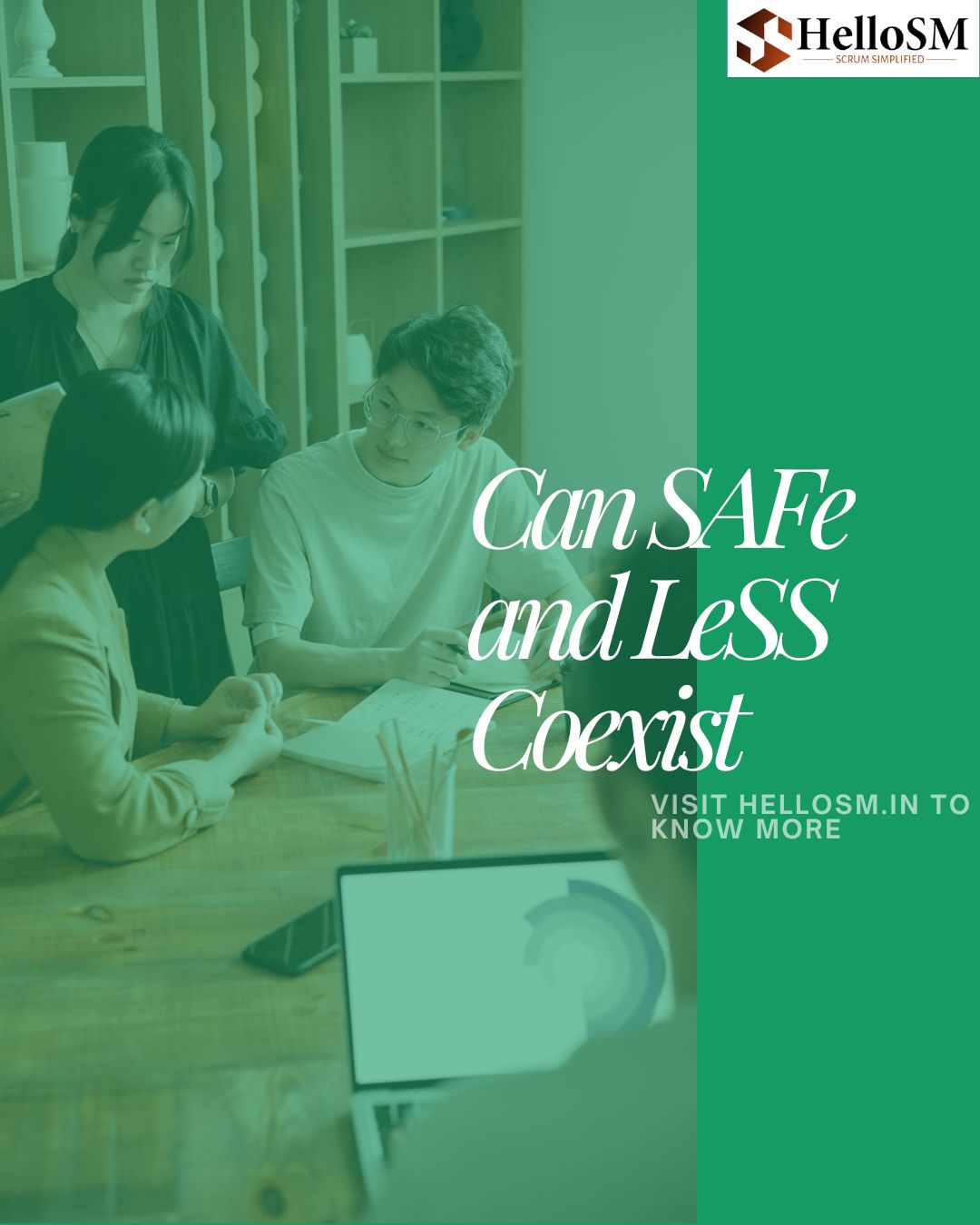As organizations grow, they often look for ways to scale Agile practices across hundreds or even thousands of people. Two of the most popular scaling options are SAFe (Scaled Agile Framework) and LeSS (Large-Scale Scrum). Both approaches have passionate supporters, but a question often arises: Can we use SAFe in the company while applying LeSS in a smaller area or department?
The answer is no. While it may sound attractive to merge them, the two models rest on very different foundations. Let’s break this down in simple terms.
Why the Idea of Mixing Appears Attractive?
On the surface, SAFe and LeSS may look similar because both are designed for large-scale product development. Many Agile coaches suggest that it is possible to run LeSS in one part of a company that has already adopted SAFe. This usually works only at a very shallow level. Teams might adjust events, align cadences, or rename roles and claim they are using LeSS inside SAFe. But this is not the real intent of LeSS. At best, it’s a lightweight tweak, not a genuine implementation.
LeSS Is About Organizational Redesign
Unlike SAFe, which gives a structured framework for scaling Agile, LeSS is a blueprint for redesigning the entire organization. It is not just about adding roles and ceremonies, it’s about changing how the company operates at a fundamental level. Implementing LeSS requires:
- Removing unnecessary layers of management.
- Redesigning reporting structures.
- Encouraging skill diversity across teams instead of rigid specializations.
- Building trust so teams can take full ownership of product delivery.
- If these deeper transformations are skipped, what remains is only a “partial LeSS,” which fails to deliver its intended benefits.
Foundation of LeSS
One of the cornerstones of LeSS is the concept of feature teams. These are cross-functional groups capable of delivering complete features end-to-end. Instead of splitting work into silos like development team, testing team, or analysis team, a feature team combines all those skills. This means a single team can take a product idea from discovery all the way to delivery. It also requires team members to build broader skill sets, moving beyond narrow specializations.
This way of working is very different from traditional corporate structures where specialists sit in separate departments with functional managers above them.
Why SAFe and LeSS Clash in Practice?
Large organizations often adopt SAFe because it provides structure: multiple levels of planning, clearly defined roles, and governance. While this makes SAFe easier to implement in a big company, it also keeps many existing management layers intact. LeSS, however, demands removing those layers. It encourages having fewer managers, no component teams, and no separate silos for functions like testing or business analysis. Instead, everyone works together in feature teams under a single Product Backlog.
When both approaches are forced into the same area, SAFe tries to keep alignment through hierarchy. LeSS tries to remove hierarchy. The result is confusion, conflicting priorities, and unclear accountability.
Is It Possible to Use Both in One Organization?
Yes, but only if they are applied in different divisions. For example, one division may continue using SAFe because it suits their governance needs, while another division experiments with LeSS for deeper structural transformation. But trying to merge them inside a single product group or department will always fail. Their underlying philosophies point in opposite directions.
Choosing the Right Framework
Scaling Agile isn’t about choosing a trendy framework, it’s about selecting the one that matches your company’s culture, size, and readiness for change. Many failures happen because organizations misunderstand what each model truly demands. This is where HelloSM comes in. Known as the best Scrum training institute in India, HelloSM helps leaders and teams understand scaling frameworks in depth. Their programs not only cover Scrum fundamentals but also explain when and how to apply models like SAFe and LeSS.
With the right knowledge, companies can avoid half-baked hybrids and focus on making one approach work effectively.
Although both SAFe and LeSS aim to solve the challenge of scaling Agile, they cannot be combined within the same organizational unit. SAFe emphasizes structured alignment through multiple layers, while LeSS requires tearing down those layers to build feature teams and simplify structures.
If your company is deciding between them, focus on the framework that best fits your goals. And if you’re serious about applying Scrum or scaling Agile properly, consider learning from experts at HelloSM, a top training institute in Hyderabad.
Frequently Asked Quesitons
Why can’t SAFe and LeSS be used in the same team or unit?
Because their foundations are opposite, SAFe keeps layered structures for alignment, while LeSS removes layers to enable cross-functional feature teams.
What makes LeSS harder to adopt than SAFe?
LeSS requires redesigning the organization, including management roles, team structures, and HR policies. SAFe, in contrast, can fit more easily into existing hierarchies.
What are feature teams in LeSS?
Feature teams are cross-functional groups that deliver complete product features from start to finish. They include all skills needed for both discovery and delivery.
Can a company try both SAFe and LeSS?
Yes, but only in separate divisions or products. Within one area, they will clash and create confusion.
Why do some organizations think a hybrid works?
Because they only apply superficial changes, such as event cadences or terminology, without addressing the deeper organizational design that LeSS requires.

